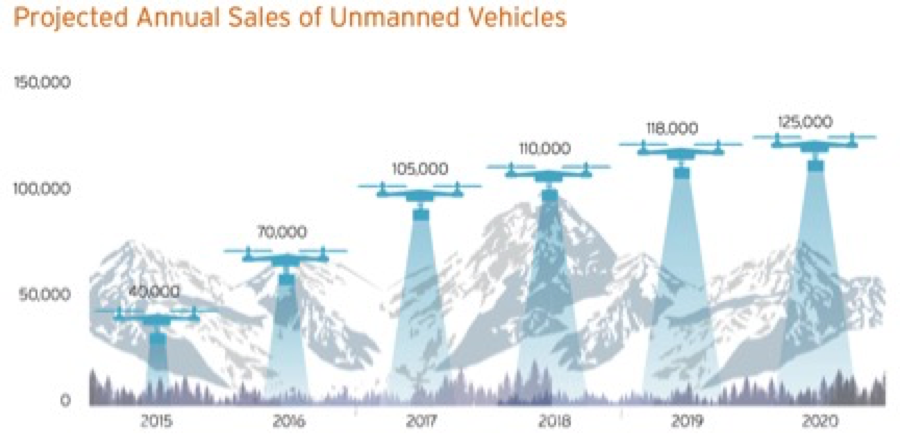In 2013, Amazon CEO Jeff Bezos announced to the world that the online retailer would begin to develop a "drone-to-door" delivery service for its loyal customers. Dubbed Amazon Prime Air, the system would deliver packages directly to your doorstep in just 30 minutes after an order is placed, setting a new and higher bar for "fast delivery."
However, after a variety of issues and concerns were addressed by increasing regulations added by the Federal Aviation Administration (FAA), it appeared that Bezos' announcement would never get off the ground. But after two years of waiting for the FAA, Amazon will finally get to test these drones on U.S. soil -- or, should I say U.S. air? -- bringing customers one step closer to having their Tide detergent refilled by a delivery drone.
Despite the U.S. government dragging behind on approvals, for retail and civilian use, sales for drones aren't expected to slow any time soon. Companies like Teal Group, an aerospace research firm, estimates that sales of both military and civilian drones will total more than $89 billion by 2023.
Other big companies, such as State Farm and AIG, are also getting into the drone business. In fact, State Farm is the first insurance company in the U.S. to receive regulatory approval to test drones for commercial use. With drones popping up in so many different industries, it makes me wonder, what impact will drones have on companies' customer experience -- good and bad?
The Good
State Farm plans on changing the insurance industry for the better, using drones to aid in natural disaster relief. For instance, instead of State Farm spending the money (and time) to ship hundreds of claims adjusters out to natural disaster sites to assess damages, the company will send only a handful of agents equipped with a drone partner to more efficiently survey damaged property.
Jason Wolf, a property defense attorney and shareholder at the Florida-based firm, Koch Parafinczuck & Wolf, stated in an interview to ClaimsJournal.com: "I envision a time when, after a catastrophe, an adjuster pulls up to a neighborhood and opens the trunk of his car and presses a few buttons on his tablet device, and the drone does an immediate survey of everything and streams it all right to his tablet device, and he knows exactly where to go first and what's most significant within minutes. Costing very little money, the insurance company has a sense of everything that needs to be done in a very short amount of time."
Imagine all the headaches this could mitigate for customers and employees after the chaos caused by unfortunate losses created by natural disasters.
It's interesting, too, how this type of surveying will require additional training, but training we might be familiar with. Much like a police officer who trains alongside his dog in a K-9 unit, insurance adjusters will train alongside their partner – only, in this industry, it would be a drone.
While there is debate in the insurance world about how drones will operate, one thing is for sure - they will be operated and used to speed up services and save on cost, making customers' lives a little easier. As such, claims assessment aided by a drone will yield quick turnarounds and an even quicker payout to the insured.
Additionally, insurance companies will start offering drone insurance to owners of unmanned aircraft systems (UAS). RiskandInsurance.com noted that the general types of coverage that will be required for the use of UAS and ancillary business activities will include liability, personal injury, invasion of privacy, property and workers' compensation. The publication also mentioned that, given the conservative nature of the insurance industry, carriers could place stricter guidelines on drone coverage than the FAA does.
Once regulated and insured, drones will be sent out into the community to collect data. For example, what if someone's home flooded? Well, insurance companies could send their drone to the flooded house and survey the area for all damages, speeding up the process for families affected.
There is also the use of drones for the collection of data by third parties. Imagine that Ford is looking to target advertisements for a new truck to areas where the road conditions would demand the use of four-wheel drive. Ford hires an agency to send out drones to specific cities where it is looking to advertise.
This drone will collect data on road conditions and take images of cars on the road to make sure a majority of drivers are in trucks, and will then report back on economic conditions. Ford doesn't want to be advertising where citizens can't or won't pay for the product.
In a world becoming more drone-centric, these types of background checks and data collections via UAS will become increasingly more frequent.
The Bad
The government review process for a drone is 120 days, but, by the end of the process, Amazon says the technology of the drone submitted for regulation is outdated. Therefore, Amazon must update its filing and submit to the FAA for regulation, starting the 120-day review process all over again.
The other concern of the FAA is air traffic. Coming down with a few regulations on drone flight, the FAA is requiring that drone controllers have sight of the drone at all times and that they must operate under 400 feet.
Exelis, a global aerospace, defense, information and services company, was featured in an article on Engadget recently, discussing its development of an air traffic control system for drones. Nearly ready for testing at the FAA approved drone-testing sites, the low-altitude monitoring system would keep tabs on compact aircrafts flying at or under the mandated 400 feet.
It'll be interesting to see how industry giants, such as Amazon, overcome these obstacles to create a non-invasive customer experience with drone technology.
Once regulated, the next issue is invasion of civilian privacy. Private and civil liberties advocates have raised doubts about the legitimacy of facial recognition cameras, thermal imaging cameras, open Wi-Fi sniffers, license plate scanners and other sensors commonly used by drones in the civilian sphere.
Civilian uses of drones for hobby are already causing issues, most notably at the White House, but across the country, as well. The LA Times reported last June that while LA Kings hockey fans were celebrating their Stanley Cup victory, a group noticed a drone flying over their heads filming the scene. Angry at the invasion of privacy, the crowd knocked the drone out of the sky using a T-shirt and then smashed it to bits with a skateboard.
In Los Angeles, flying a drone in public is not illegal, but LAPD Cmdr. Andrew Smith commented that, "It was kind of an eye-opener for us, that this something we really need to pay attention to." While the Kings fans reactions may seem a little over the top, the general population seems to feel the same way when they see a drone overhead.
With no official laws on the books regarding the use of domestic drones, the right to privacy becomes a large topic of concern for many citizens. The American Civil Liberties Union states on its website, "Congress has ordered the Federal Aviation Administration to change airspace rules to make it much easier for police nationwide to use domestic drones, but the law does not include badly needed privacy protections."
It will be interesting to see how industries promote drone use to their customers, without raising fears about a threat to privacy. After all, customers may not always be right, but they are always the customers.
Drones will also need to be protected from cyber attacks.
"Cyberattacks on your PC - they can steal information, and they can steal money, but they don't cause physical damage, whereas cyber-attacks in a UAV or a car can cause physical damage, and we really don't want to open that can of worms," said Kathleen Fisher, the previous program manager of the DARPA project in a statement to NextGov.com
The Pentagon is currently working on developing code that will protect a Boeing Little Bird unmanned aircraft from being hacked. Defense industry programmers are rewriting software to safeguard the computer onboard the helicopter drone and aim to have the project completed by 2017.
The Future
It's exciting to think about what drone technology will bring to companies and their customers - and to people everywhere. Let's face it, if we think we have seen the complete potential of what customer experience has to offer, then, well, we're being naive. The new drone technology will reinvent customer experience once again. And the best part? We all get to see how it unfolds.
The future seems endless for drones. Whether you feel they are an invasion of privacy, or they will begin to make our lives easier and aid society in ways that haven't even been thought of yet, drones aren't going anywhere any time soon. If you need to put it in perspective, a white paper featured on Cognizant.com notes that 40,000 drones are expected to deploy in 2015, and this is a number that will continue to increase each year. This industry is ready for take-off.
If you haven't come face-to-face with a drone yet, don't worry, you will.






